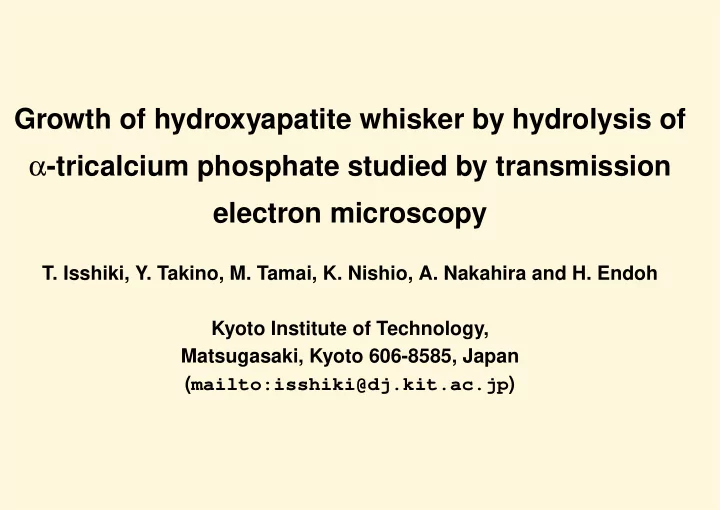

Growth of hydroxyapatite whisker by hydrolysis of α -tricalcium phosphate studied by transmission electron microscopy T. Isshiki, Y. Takino, M. Tamai, K. Nishio, A. Nakahira and H. Endoh Kyoto Institute of Technology, Matsugasaki, Kyoto 606-8585, Japan ( mailto:isshiki@dj.kit.ac.jp )
Introduction Hydroxyapatite Hydroxyapatite ( Ca 10 ( PO 4 ) 6 ( OH ) 2 : HAp) • Crystal structure: Similar to a bone ⇓ widely noticed and expected • As an alternative material for bone • Application to a biosensor making good use of biocompatibility
Synthesis of Hydroxyapatite • Dry process ⇒ Stoichiometric HAp 6CaHPO 4 + 4CaCO 3 → HAp + 2H 2 O + 4CO 2 • Wet process ⇒ Non-stoichiometric HAp – Sol-gel method – Hydrolysis method [1]
Ca-deficient Hydroxyapatite [1] α -tricalcium phosphate ( α - Ca 3 ( PO 4 ) 2 : α -TCP) ⇓ Hydrolysis in a mixture of water and alcohol Ca-deficient HAp ( Ca 10 − Z ( HPO 4 ) Z ( PO 4 ) 6 − Z ( OH ) 2 − Z ⋅ n H 2 O ( Z = 0 - 1 ) ) The merits • Easy to systhesis (under mild environment within several hours)
• Control of crystal morphology • Whisker shape favorable as a source to produce porous biomaterials Investigation It is discussed that the crystal growth of HAp whiskers produced by hydrolysis of α -TCP studied by transmission electron microscopy (TEM).
Experimental Procedure α -TCP powder Sintered and shaped into a disk Thinned with a dimple grinder Thin α -TCP α -TCP powder for HRTEM for mass production observation
Hydrolysis in a water solvent suspending 1-octanol α -TCP : water : 1-octanol = 0.01 mol : 100 ml : 60 ml Initial pH = 11 (adjusted with NH 4 OH) Stirred at 70 C for 1, 2, 3, 4, 5, 24, and 48 hours Dripped on a TEM grid Specimen I Specimen II TEM observation : JEOL JEM-2010/SP & JEM-2000EX
Results and Discussion Initial stage of hydrolysis TEM images of the thinned sample ( Specimen I ) are shown in Figs. 1-3 . The surface of the α -TCP was clean before hydroly- Fig. 1 Surface of α -TCP sis as shown in Fig. 1 . before hydrolysis.
The surface of the α -TCP hydrolyzed for a few hours was covered with an amorphous layer ( Fig. 2 ). Nuclei appeared not on the α -TCP crystal but on the surface of the amorphous layer ( Fig. 3 a , b), and they grew into the dendritic structure com- posed of twigs with a few nm in width and trunks with several tens nm in width ( Fig. 3 c). The den- drites are regarded as an embryo of HAp crystal. Fig. 3 (right) TEM images of the surface of α -TCP hydrolyzed for 2 ( a ) and 4 ( b , c ) hours, respectively.
Fig. 2 ( a ) TEM image of α -TCP hydrolyzed for 2 hours, ( b , c ) enlarged images of the areas indicated by squares in a , respectively, and ( d ) SAED pattern of the area c .
Growth of hydroxyapatite whiskers Figs. 4, 5 show that the progress of hydrolysis of the α -TCP powder ( Specimen II ) and conversion ratio of HAp to α -TCP calculated from the X-ray diffraction intensities obtained from the samples.
Fig. 4 ( a - f ) TEM images of the samples hydrolyzed for 0, 1, 2, 3, 5, and 48 hours, respectively.
Needle-like HAp crystals with a few tens nm in width and a few hundreds nm in length grew around the α -TCP particle after hydrolysis for 1 hour ( Fig. 4 b). After 3 hours of hydrolysis, most of growing HAp crystals had whisker shape ( Fig. 4 d). Growth of the needle-like HAp crystal oc- curs at first, and then deposition of HAp on the needle-like crystals and aggregation of them form HAp whiskers. Hydrolysis of the α -TCP powder ( Specimen II ) was completed in 3 hours ( Figs. 4 d - f , 5 ).
100 HAp 48 h Conversion rate [%] 80 Intensity [a.u.] 24 h 60 3 h 2 h 40 1 h 20 0 h 0 0 1 2 3 4 5 20 30 40 50 a b Diffraction angle 2 θ [degree] Hydrolyzed time [hour] Fig. 5 Dependence of conversion rate to HAp from α -TCP on hydrolyzed time ( a ) calculated from X-ray diffraction intensities obtained from the samples at various hydrolyzed time ( b ).
Summary Growth process of HAp whiskers by hydrolysis of α -TCP is schematically illustrated as follows. α -TCP Surface is dissolved Amorphous layer on the surface of α -TCP
Nucleation of HAp on the amorphous layer Deposition from the solution Dendrite structures on the nuclei
Successive deposition Needle-like HAp crystals Successive deposition and aggre- gation HAp whiskers
References [1] A. Nakahira, K. Sakamoto, S. Yamaguchi, M. Ka- neno, S. Takeda and M. Okazaki, J. Am. Ceram. Soc. 82 (1999) 2029-2032
Recommend
More recommend